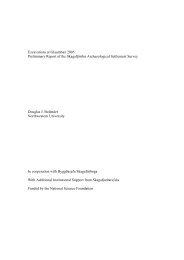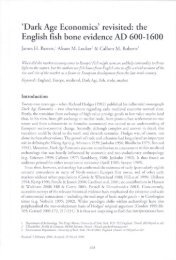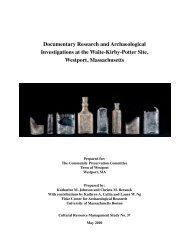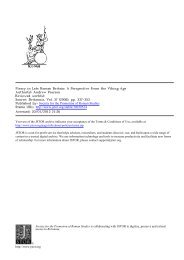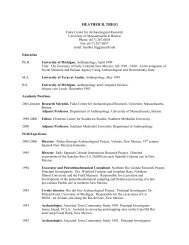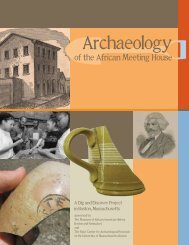archaeological site examination north yard of the ... - Fiske Center
archaeological site examination north yard of the ... - Fiske Center
archaeological site examination north yard of the ... - Fiske Center
You also want an ePaper? Increase the reach of your titles
YUMPU automatically turns print PDFs into web optimized ePapers that Google loves.
V. ARCHAEOLOGICALSITE EXAMINATION<br />
A. Research Design<br />
The Loring-Greenough House property,<br />
consisting <strong>of</strong> <strong>the</strong> eighteenth-century mansion,<br />
nineteenth century carriage house and<br />
gardens is <strong>the</strong> only surviving example <strong>of</strong> a<br />
colonial country estate in <strong>the</strong> Jamaica Plain<br />
neighborhood <strong>of</strong> Boston. The house is a<br />
Massachusetts Historic Landmark because<br />
<strong>of</strong> its historical connections to <strong>the</strong> American<br />
Revolution and its exemplification <strong>of</strong><br />
Colonial architecture. This status implies<br />
that any subsurface cultural remains are<br />
considered significant due to <strong>the</strong>ir potential<br />
to contribute data to <strong>the</strong> prehistoric and historic<br />
interpretation <strong>of</strong> <strong>the</strong> property. The primary<br />
goal <strong>of</strong> <strong>the</strong> <strong>site</strong> <strong>examination</strong> was to<br />
determine whe<strong>the</strong>r extant garden features<br />
were historically significant and <strong>the</strong>refore<br />
worthy <strong>of</strong> inclusion in proposed garden<br />
restoration efforts.<br />
By <strong>the</strong> 18th century, gardens had taken on a<br />
dual function that combined utilitarian<br />
needs with an increasingly popular colonial<br />
aes<strong>the</strong>tic that favored <strong>the</strong> creation <strong>of</strong> visually<br />
appealing landscapes. Over time <strong>the</strong><br />
arrangement <strong>of</strong> plantings within <strong>the</strong> utilitarian<br />
vegetable garden were combined with<br />
fruit trees and shrubs to create spaces that<br />
were not only functional, but were also aes<strong>the</strong>tically<br />
pleasing. Thus, <strong>the</strong> concept <strong>of</strong><br />
<strong>the</strong> garden was transformed from a place <strong>of</strong><br />
work to a place <strong>of</strong> recreation and beauty.<br />
Because it was <strong>the</strong> wealthy who maintained<br />
<strong>the</strong> means <strong>of</strong> creating and maintaining such<br />
spaces, gardens became synonymous with<br />
<strong>the</strong> image <strong>of</strong> <strong>the</strong> colonial gentleman and<br />
came to serve, in addition to <strong>the</strong> estate<br />
house, as a symbol <strong>of</strong> one’s wealth and status<br />
(Yentsch 1996). The 1779 description<br />
<strong>of</strong> Joshua Loring’s property includes mention<br />
<strong>of</strong> gardens and fruit trees. Although<br />
Loring was an individual <strong>of</strong> high repute<br />
with a distinguished military career, it is not<br />
known if he conformed to popular upper<br />
class taste by maintaining a formal garden.<br />
The popularity <strong>of</strong> <strong>the</strong> garden with its<br />
romantic associations and its connection to<br />
a purer perception <strong>of</strong> <strong>the</strong> past (Beaudry<br />
1996:3) extended <strong>the</strong> appreciation <strong>of</strong> gardens<br />
through <strong>the</strong> nineteenth century, implying<br />
that <strong>the</strong> Greenough family, too, might<br />
have maintained a formal garden space on<br />
<strong>the</strong> property similar to that known to have<br />
been present at <strong>the</strong> Longfellow House in<br />
Cambridge (Pendery 2002, 2003). The<br />
continued popularity <strong>of</strong> decorative gardens<br />
in <strong>the</strong> twentieth century (Binzen and Kelley<br />
2000, Binzen et. al. 2002) suggests that <strong>the</strong><br />
geometrically arranged garden depicted on<br />
<strong>the</strong> 1937 HABS plan, in fact, may have<br />
been constructed more recently.<br />
Archaeology has become a valuable tool in<br />
<strong>the</strong> identification and eventual restoration<br />
<strong>of</strong> early gardens (Kelso, 1990; Leone 1984,<br />
1988; Yentsch 1994). A multidisciplinary<br />
approach to landscape design that combines<br />
non-destructive remote sensing techniques<br />
along with documentary research to generate<br />
both emic and etic perspectives, careful<br />
excavation and soil analysis and detailed<br />
mapping <strong>of</strong> extant vegetation is now considered<br />
standard for such projects (Me<strong>the</strong>ny<br />
et. al. 1999; Yentsch 1994). The investigation<br />
<strong>of</strong> <strong>the</strong> Loring-Greenough House North<br />
Yard is limited in scope and, <strong>the</strong>refore, is<br />
reliant upon careful observation <strong>of</strong> stratigraphic<br />
sequences and features. The<br />
<strong>archaeological</strong> identification <strong>of</strong> garden<br />
related features is contingent upon <strong>the</strong> presence<br />
<strong>of</strong> specific indicators. These can<br />
include differences in soil type, texture and<br />
elevation across <strong>the</strong> <strong>site</strong>, borders that are<br />
indicated by soil differences, <strong>the</strong> presence<br />
<strong>of</strong> walkways or edging that may appear as<br />
linear arrangements <strong>of</strong> post holes, bricks or<br />
o<strong>the</strong>r border materials as well as indications<br />
<strong>of</strong> specific plant locations. Plant locations<br />
are generally defined by depressions or<br />
holes that have been backfilled with soil<br />
that can be differentiated from surrounding<br />
matrix due to obvious or subtle alterations<br />
in soil color, texture and composition.<br />
Occasionally artifacts are incorporated into<br />
<strong>the</strong> back fill <strong>of</strong> planting holes that also aid<br />
in identification and dating.<br />
18



